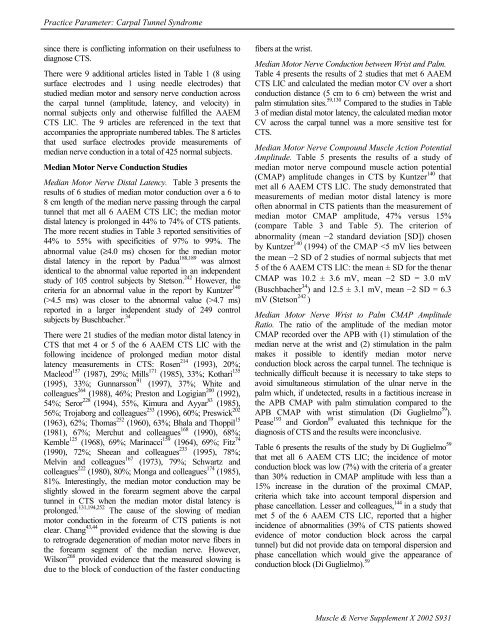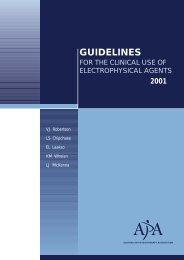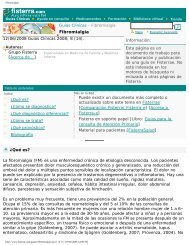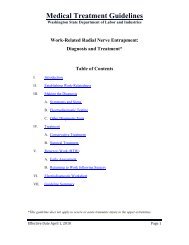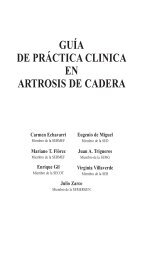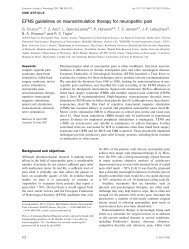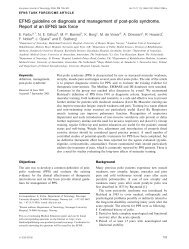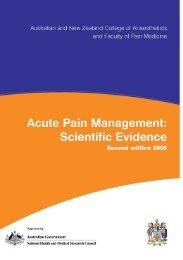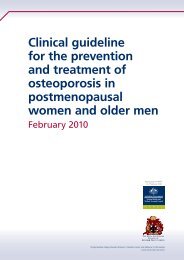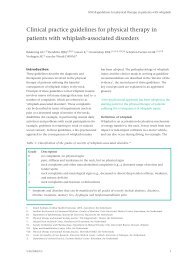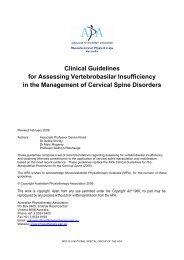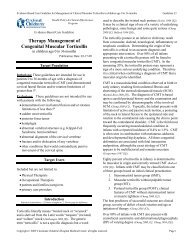<strong>Practice</strong> <strong>Parameter</strong>: Carpal Tunnel SyndromeTo evaluate <strong>the</strong> specificity <strong>of</strong> NCSs for <strong>the</strong> diagnosis <strong>of</strong>CTS, investigators have used clinical criteria for <strong>the</strong>diagnosis <strong>of</strong> CTS independent <strong>of</strong> EDX findings, performedprospective studies, <strong>and</strong> included concomitant evaluation <strong>of</strong>normal control subjects. 110 The results <strong>of</strong> <strong>the</strong>se clinicalresearch efforts have found rapid application in <strong>the</strong> clinicallaboratory. Physicians in several specialties, includingneurology, physical medicine <strong>and</strong> rehabilitation,orthopaedics, neurosurgery, plastic surgery, rheumatology,<strong>and</strong> occupational medicine have concluded that NCSs <strong>and</strong>needle EMG are <strong>of</strong> value for <strong>the</strong> laboratory diagnosis <strong>of</strong>CTS. 77,80,110,121,243 In a multidiscipline consensus forum,Rempel <strong>and</strong> colleagues 205 concluded that NCSs, combinedwith <strong>the</strong> clinical history <strong>and</strong> clinical findings, provide abetter basis for <strong>the</strong> diagnosis <strong>of</strong> CTS than <strong>the</strong> clinical history<strong>and</strong> clinical finding alone.Several investigators have studied <strong>the</strong> relationship between<strong>the</strong> abnormalities on NCSs <strong>and</strong> <strong>the</strong> duration <strong>and</strong> severity <strong>of</strong>symptoms <strong>and</strong> signs <strong>of</strong> CTS. Patients with weakness <strong>and</strong>/orsensory deficits frequently have low amplitude motor <strong>and</strong>/orsensory potentials, respectively. 85,251 Although <strong>the</strong> incidence<strong>of</strong> abnormalities <strong>of</strong> median sensory <strong>and</strong> motor conduction isgreater when <strong>the</strong> duration <strong>of</strong> <strong>the</strong> symptoms <strong>of</strong> CTS islonger, <strong>the</strong>re are definite exceptions. 251 Fur<strong>the</strong>rmore, in1963, Fullerton 76 demonstrated that <strong>the</strong> susceptibility <strong>of</strong>median motor nerve conduction across <strong>the</strong> wrist to ischemiacorrelated with <strong>the</strong> frequency <strong>and</strong> severity <strong>of</strong> intermittentattacks <strong>of</strong> pain <strong>and</strong> pares<strong>the</strong>sias in <strong>the</strong> affected h<strong>and</strong>;slowing <strong>of</strong> motor nerve conduction (prolonged distallatency) did not correlate with pain <strong>and</strong> pares<strong>the</strong>sias.Fullerton 76 suggested that <strong>the</strong>re were 2 mechanismsresponsible for <strong>the</strong> symptoms <strong>and</strong> signs <strong>of</strong> CTS: (1) arapidly reversible change in <strong>the</strong> nerve fibers associated withischemic attacks, <strong>and</strong> (2) a slowly developing structuralchange in <strong>the</strong> nerve fibers resulting from pressure on <strong>the</strong>nerve under <strong>the</strong> flexor retinaculum. In 1980, Gilliatt 82reviewed additional evidence to support Fullerton’shypo<strong>the</strong>sis which provides an explanation for <strong>the</strong> promptrelief <strong>of</strong> some symptoms <strong>of</strong> CTS with surgicaldecompression <strong>of</strong> <strong>the</strong> carpal tunnel.Motor <strong>and</strong> sensory NCSs can be performed in <strong>the</strong> clinicallaboratory setting with surface stimulating <strong>and</strong> recordingelectrodes. 85,141,252 The technical factors that influence <strong>the</strong>results <strong>of</strong> <strong>the</strong>se studies have been identified to include <strong>the</strong>following: amplifier gain <strong>and</strong> filter settings; electrode size,shape, <strong>and</strong> material; distance between stimulating <strong>and</strong>recording electrodes; distance between recording electrodes;<strong>and</strong> limb temperature. Pathologic conditions which causenerve damage also alter <strong>the</strong> results <strong>of</strong> NCSs by slowing orblocking nerve conduction. NCSs provide a unique <strong>and</strong>reliable method for assessing directly <strong>the</strong> integrity <strong>of</strong>sensory <strong>and</strong> motor nerve fibers. 82,83Needle EMG is performed by inserting a sterile needleelectrode through <strong>the</strong> skin into <strong>the</strong> belly <strong>of</strong> a muscle <strong>and</strong>evaluating <strong>the</strong> spontaneous <strong>and</strong> voluntary electrical activityin <strong>the</strong> muscle. The technical factors that influence <strong>the</strong> results<strong>of</strong> <strong>the</strong>se studies have been identified <strong>and</strong> include amplifiergain <strong>and</strong> filter settings <strong>and</strong> electrode size, shape, <strong>and</strong>material. After injury <strong>of</strong> a nerve to a muscle, abnormalelectrical activity can be recorded in <strong>the</strong> muscle, whichserves to provide objective evidence <strong>of</strong> motor nerve injury.NCSs <strong>and</strong> needle EMG are complementary but distinctlydifferent EDX techniques although <strong>the</strong>y are <strong>of</strong>ten performedsequentially for <strong>the</strong> evaluation <strong>of</strong> clinical problems. Because<strong>the</strong> use <strong>of</strong> NCSs <strong>and</strong> needle EMG requires (1) <strong>the</strong> formulation<strong>of</strong> a differential diagnosis based on <strong>the</strong> clinical history <strong>and</strong>physical examination, (2) interpretation <strong>of</strong> <strong>the</strong> data during <strong>the</strong>examination, <strong>and</strong> (3) a change in <strong>the</strong> direction <strong>of</strong> <strong>the</strong>examination during <strong>the</strong> study based upon that interpretationintegrated with clinical information, NCSs <strong>and</strong> EMG are <strong>the</strong>practice <strong>of</strong> medicine <strong>and</strong> should be performed by a physicianqualified by education, training, <strong>and</strong> experience. 6RESULTSThe article review process was designed to ensure that all <strong>of</strong><strong>the</strong> articles cited used comparable scientific methods toevaluate <strong>the</strong> proposed EDX study. Some variation is to beexpected in <strong>the</strong> results even with identical techniquesbecause <strong>the</strong> percentage <strong>of</strong> abnormal values depends onseveral factors including (1) <strong>the</strong> number <strong>of</strong> <strong>and</strong> selectionprocess for <strong>the</strong> normal subjects, (2) <strong>the</strong> number <strong>of</strong> <strong>and</strong>selection process for <strong>the</strong> CTS patients—few articlesdescribed in detail <strong>the</strong> clinical criteria for <strong>the</strong> diagnosis <strong>of</strong>CTS or <strong>the</strong> severity <strong>of</strong> <strong>the</strong> CTS in <strong>the</strong> patients entered in <strong>the</strong>study, <strong>and</strong> (3) <strong>the</strong> numeric value chosen as <strong>the</strong> upper limit <strong>of</strong>normal for <strong>the</strong> NCS.A total <strong>of</strong> 22 <strong>of</strong> <strong>the</strong> 320 articles <strong>and</strong> abstracts reviewed metall 6 AAEM CTS LIC (see Table 1) <strong>and</strong> 16 <strong>of</strong> <strong>the</strong>se 22articles were selected as <strong>the</strong> source <strong>of</strong> <strong>the</strong> data displayed inTables 3 through 22. 38,39,47,57,59,110,130,140,181,182,188,189,221,223,237,254 The 16 articles selected for <strong>the</strong> tables: (1) met all 6 CTSLIC, (2) used surface recording electrodes for NCSs, (3) useda technique that evaluated median nerve conduction with <strong>the</strong>wrist in a neutral position <strong>and</strong> <strong>the</strong> h<strong>and</strong> in a rested state, <strong>and</strong>(4) reported median nerve conduction abnormalities in atotal <strong>of</strong> 1812 CTS patients <strong>and</strong> a total <strong>of</strong> 678 normalsubjects. The data from <strong>the</strong> remaining 6 articles are discussedin <strong>the</strong> text but were not used as a source <strong>of</strong> Tabledata 30,31,48,213,248,262 because: (1) 3 investigators 30,31,248 usedsubdermal needle electrodes for stimulating <strong>and</strong>/orrecording electrodes for all <strong>of</strong> <strong>the</strong> NCSs (1 used needlerecording electrodes for <strong>the</strong> median sensory NCS <strong>and</strong> surfaceelectrodes for <strong>the</strong> median motor NCS 29 ), <strong>and</strong> needleelectrodes are not generally used for NCS, 239 <strong>and</strong> (2) 3additional articles 48,213,262 reported <strong>the</strong> effect <strong>of</strong> wristpositioning <strong>and</strong>/or h<strong>and</strong> movements on median NCS <strong>and</strong><strong>the</strong>se studies are best viewed as investigational techniquesS930 CTS <strong>Literature</strong> <strong>Review</strong>© 2002 American Association <strong>of</strong> Electrodiagnostic Medicine
<strong>Practice</strong> <strong>Parameter</strong>: Carpal Tunnel Syndromesince <strong>the</strong>re is conflicting information on <strong>the</strong>ir usefulness todiagnose CTS.There were 9 additional articles listed in Table 1 (8 usingsurface electrodes <strong>and</strong> 1 using needle electrodes) thatstudied median motor <strong>and</strong> sensory nerve conduction across<strong>the</strong> carpal tunnel (amplitude, latency, <strong>and</strong> velocity) innormal subjects only <strong>and</strong> o<strong>the</strong>rwise fulfilled <strong>the</strong> AAEMCTS LIC. The 9 articles are referenced in <strong>the</strong> text thataccompanies <strong>the</strong> appropriate numbered tables. The 8 articlesthat used surface electrodes provide measurements <strong>of</strong>median nerve conduction in a total <strong>of</strong> 425 normal subjects.Median Motor Nerve Conduction StudiesMedian Motor Nerve Distal Latency. Table 3 presents <strong>the</strong>results <strong>of</strong> 6 studies <strong>of</strong> median motor conduction over a 6 to8 cm length <strong>of</strong> <strong>the</strong> median nerve passing through <strong>the</strong> carpaltunnel that met all 6 AAEM CTS LIC; <strong>the</strong> median motordistal latency is prolonged in 44% to 74% <strong>of</strong> CTS patients.The more recent studies in Table 3 reported sensitivities <strong>of</strong>44% to 55% with specificities <strong>of</strong> 97% to 99%. Theabnormal value (≥4.0 ms) chosen for <strong>the</strong> median motordistal latency in <strong>the</strong> report by Padua 188,189 was almostidentical to <strong>the</strong> abnormal value reported in an independentstudy <strong>of</strong> 105 control subjects by Stetson. 242 However, <strong>the</strong>criteria for an abnormal value in <strong>the</strong> report by Kuntzer 140(>4.5 ms) was closer to <strong>the</strong> abnormal value (>4.7 ms)reported in a larger independent study <strong>of</strong> 249 controlsubjects by Buschbacher. 34There were 21 studies <strong>of</strong> <strong>the</strong> median motor distal latency inCTS that met 4 or 5 <strong>of</strong> <strong>the</strong> 6 AAEM CTS LIC with <strong>the</strong>following incidence <strong>of</strong> prolonged median motor distallatency measurements in CTS: Rosen 214 (1993), 20%;Macleod 157 (1987), 29%; Mills 171 (1985), 33%; Kothari 135(1995), 33%; Gunnarsson 91 (1997), 37%; White <strong>and</strong>colleagues 264 (1988), 46%; Preston <strong>and</strong> Logigian 200 (1992),54%; Seror 228 (1994), 55%, Kimura <strong>and</strong> Ayyar 83 (1985),56%; Trojaborg <strong>and</strong> colleagues 253 (1996), 60%; Preswick 202(1963), 62%; Thomas 252 (1960), 63%; Bhala <strong>and</strong> Thoppil 15(1981), 67%; Merchut <strong>and</strong> colleagues 168 (1990), 68%;Kemble 125 (1968), 69%; Marinacci 159 (1964), 69%; Fitz 74(1990), 72%; Sheean <strong>and</strong> colleagues 233 (1995), 78%;Melvin <strong>and</strong> colleagues 167 (1973), 79%; Schwartz <strong>and</strong>colleagues 222 (1980), 80%; Monga <strong>and</strong> colleagues 174 (1985),81%. Interestingly, <strong>the</strong> median motor conduction may beslightly slowed in <strong>the</strong> forearm segment above <strong>the</strong> carpaltunnel in CTS when <strong>the</strong> median motor distal latency isprolonged. 131,194,252 The cause <strong>of</strong> <strong>the</strong> slowing <strong>of</strong> medianmotor conduction in <strong>the</strong> forearm <strong>of</strong> CTS patients is notclear. Chang 43,44 provided evidence that <strong>the</strong> slowing is dueto retrograde degeneration <strong>of</strong> median motor nerve fibers in<strong>the</strong> forearm segment <strong>of</strong> <strong>the</strong> median nerve. However,Wilson 268 provided evidence that <strong>the</strong> measured slowing isdue to <strong>the</strong> block <strong>of</strong> conduction <strong>of</strong> <strong>the</strong> faster conductingfibers at <strong>the</strong> wrist.Median Motor Nerve Conduction between Wrist <strong>and</strong> Palm.Table 4 presents <strong>the</strong> results <strong>of</strong> 2 studies that met 6 AAEMCTS LIC <strong>and</strong> calculated <strong>the</strong> median motor CV over a shortconduction distance (5 cm to 6 cm) between <strong>the</strong> wrist <strong>and</strong>palm stimulation sites. 59,130 Compared to <strong>the</strong> studies in Table3 <strong>of</strong> median distal motor latency, <strong>the</strong> calculated median motorCV across <strong>the</strong> carpal tunnel was a more sensitive test forCTS.Median Motor Nerve Compound Muscle Action PotentialAmplitude. Table 5 presents <strong>the</strong> results <strong>of</strong> a study <strong>of</strong>median motor nerve compound muscle action potential(CMAP) amplitude changes in CTS by Kuntzer 140 thatmet all 6 AAEM CTS LIC. The study demonstrated thatmeasurements <strong>of</strong> median motor distal latency is more<strong>of</strong>ten abnormal in CTS patients than <strong>the</strong> measurement <strong>of</strong>median motor CMAP amplitude, 47% versus 15%(compare Table 3 <strong>and</strong> Table 5). The criterion <strong>of</strong>abnormality (mean –2 st<strong>and</strong>ard deviation [SD]) chosenby Kuntzer 140 (1994) <strong>of</strong> <strong>the</strong> CMAP


